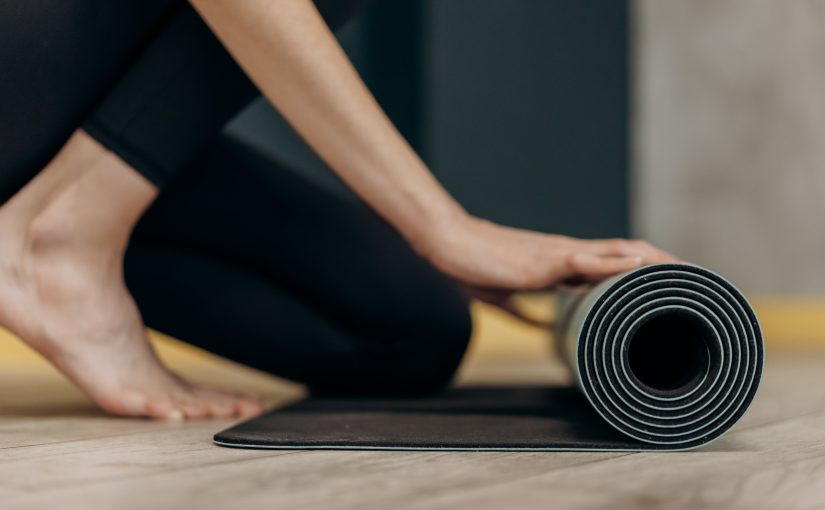Whether you’re a seasoned yogi. yoga instructor, or a beginner taking your first steps onto the mat, one essential piece of equipment can make or break your practice: the yoga mat.
Choosing the right yoga mat is crucial for comfort, stability, and support during your practice. In this article, we’ll guide you through selecting the perfect yoga mat to enhance your yoga journey.
The Importance of the Yoga Mat
Before we delve into the factors to consider when choosing a yoga mat, it’s essential to understand why it matters. Your yoga mat serves as your sacred space, your foundation for practice. It provides a stable surface for your poses, cushions your joints, and offers traction to prevent slips and falls. A comfortable and reliable yoga mat enhances your practice and promotes safety and hygiene.
Consider Your Yoga Style
The first step in choosing a yoga mat is considering your preferred style. Different styles of yoga may have specific requirements for mat thickness, texture, and grip. Here are a few examples:
- Hatha and Gentle Yoga: These styles involve slower-paced, gentle movements and are generally well-suited to thicker and more cushioned mats, providing comfort during longer holds.
- Vinyasa and Power Yoga: These dynamic styles involve fluid transitions and might require a mat with good grip to prevent slipping. A thinner mat with a non-slip surface is often preferred.
- Hot Yoga: A mat with excellent grip and moisture-wicking properties is essential in hot yoga classes, where you’ll be sweating profusely.
- Yin Yoga: For this style, a thicker, cushioned mat can enhance comfort during long, passive holds.
Key Factors to Consider
Now, let’s explore the critical factors to consider when choosing a yoga mat:
1. Thickness: Yoga mats come in various thicknesses, typically ranging from 1/16 inch (1.5mm) to 1/4 inch (6mm) or more. The right thickness for you depends on your yoga style and personal preference. Thicker mats offer more cushioning for your joints but can be less stable for balancing poses. Thinner mats provide a firmer base for balance but offer less cushioning.
2. Material: Yoga mats are made from various materials, including PVC, TPE, rubber, cork, and natural rubber. Consider factors like eco-friendliness, durability, and texture when choosing a material. PVC mats are durable but less eco-friendly, while natural rubber and cork mats are sustainable choices.
3. Texture: The texture of your mat’s surface affects grip and comfort. Mats with a textured surface can provide better traction, reducing the risk of slipping during practice. However, some people prefer a smoother surface for ease of movement.
4. Size: Standard yoga mats are around 68-72 inches long and 24-26 inches wide. If you’re taller, consider an extra-long mat (about 84 inches) to ensure you have enough space for your practice. Also, think about portability; thicker mats can be heavier.
5. Stickiness: A good grip is essential to prevent slipping, especially in styles like hot yoga. Look for mats with a non-slip surface, or consider using a yoga towel for added traction.
6. Weight: If you plan to carry your mat to and from yoga classes, weight is a crucial factor. Lighter mats are more portable, while thicker, cushioned mats can be heavier.
7. Eco-Friendliness: If environmental sustainability is important to you, choose a mat made from eco-friendly materials like natural rubber, cork, or TPE (thermoplastic elastomer).
8. Price: Yoga mats come in various price ranges. While finding a mat that fits your budget is essential, remember that investing in a quality mat can enhance your practice and durability.
9. Maintenance: Consider how easy the mat is to clean. Mats with closed-cell surfaces are easier to wipe down, making them ideal for hot yoga or those who sweat a lot.
10. Personal Comfort: Your comfort is the most crucial factor. Try out different mats in a yoga studio or store to see how they feel beneath you.
Mat Care and Longevity
Once you’ve found the perfect yoga mat, taking care of it is essential to ensure its longevity. Here are some tips for mat care:
- Regular Cleaning: Clean your mat regularly, especially if you sweat a lot during practice. Use a mat cleaner or a mixture of water and a few drops of mild soap. Avoid using harsh chemicals that can damage the material.
- Air Drying: After cleaning, allow your mat to air dry thoroughly before rolling it up. Avoid direct sunlight, as it can degrade some mat materials.
- Roll, Don’t Fold: Roll your mat rather than folding it to prevent creases and damage to the surface.
- Storage: Store your mat in a cool, dry place when not in use. Avoid leaving it in extreme temperatures or direct sunlight for prolonged periods.
- Yoga Towel: Consider using a yoga towel on top of your mat, especially during hot yoga classes, to absorb moisture and prolong the life of your mat.
Your Yoga Journey Begins with the Right Mat
Choosing a yoga mat may seem simple, but it’s a significant step in enhancing your yoga practice. The right mat can provide comfort, stability, and support, allowing you to immerse yourself in your practice fully.
If you’ve dreamed of becoming a certified yoga instructor, then consider an affordable yoga teacher training Bali course. It could be an ideal choice, as you deepen your practice, explore yoga philosophies, and connect with like-minded individuals, all without breaking the bank. Attending a yoga teacher training program can also increase your knowledge of mats, blocks, and much more.
Consider your yoga style, personal preferences, and environmental concerns when selecting a mat. With the perfect mat beneath you, you’ll be on your way to a more fulfilling and enjoyable yoga journey.
